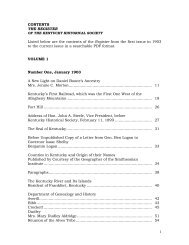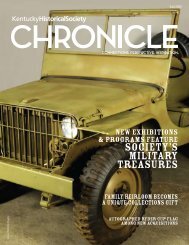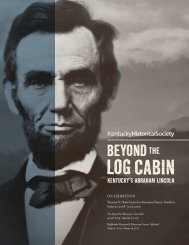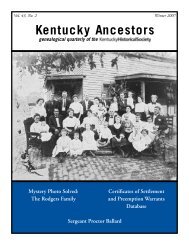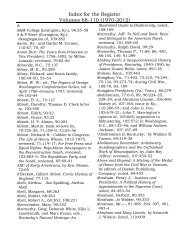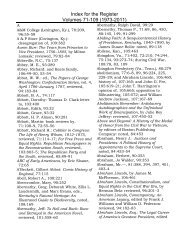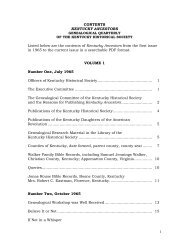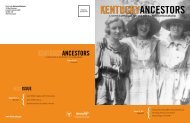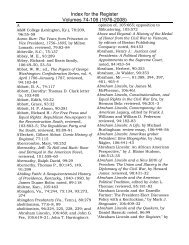kentucky decorative arts treasures - Kentucky Historical Society
kentucky decorative arts treasures - Kentucky Historical Society
kentucky decorative arts treasures - Kentucky Historical Society
Create successful ePaper yourself
Turn your PDF publications into a flip-book with our unique Google optimized e-Paper software.
During the first part of his life, he was overdependent<br />
on his parent’s generosity but then later became<br />
overburdened with their care. A final decline into<br />
alcoholism killed him at an early age. At the same<br />
time, he was an enchanting companion to all those<br />
who left first-hand accounts of him behind, as<br />
“courtesy was a genuine feature of his personality. He<br />
appears to have exercised good manners in all kinds<br />
of situations toward people of all social classes.” The<br />
transformation of Sawyier’s watercolors into a print<br />
industry in the 1960s revived the oral history that he<br />
was a talented drunk willing to paint for a few dollars<br />
to buy his hooch and that he died before his real<br />
potential could be fulfilled. Those prints also ensured<br />
that he was overexposed and underappreciated,<br />
relegated to the role of a quaint local practitioner<br />
whose pretty pictures satisfied a nostalgic hunger for<br />
images of idyllic <strong>Kentucky</strong> landscapes. We should<br />
be able to see Sawyier for exactly what he was—a<br />
painter with a very sensitive eye for the nuances of<br />
the <strong>Kentucky</strong> landscape, one who painted in colors<br />
tenderly combined and deftly applied. Consideration<br />
of his work returns us to the difficult, though timehonored<br />
determination of what is beautiful, indeed<br />
what is beauty. Beauty is about good form. Sawyier saw<br />
the good form of the <strong>Kentucky</strong> landscape, the totality of<br />
that form, which he painted as his experience of light,<br />
air, water, earth, and foliage. Appreciation of his art<br />
comes from an innate response to that totality, a response<br />
magnified by a personal love of the land. Bright with<br />
subtle color contrasts and bravura brush stroke, Sawyier’s<br />
paintings are as ephemeral as a summer day. If there were<br />
demons in his soul, they were certainly not manifest in the<br />
greener pastures he so freshly rendered.<br />
(opposite, clockwise from top right)<br />
Big Eddy, Paul Sawyier (1865-1917), ca. 1900<br />
Donated by Mary Discher Kelly, 1997.8<br />
Bench, ca. 1880, cane and oak<br />
<strong>Kentucky</strong> <strong>Historical</strong> <strong>Society</strong> Collections, 1939.736<br />
“Hedge House Stripe,” American, 1865-1875<br />
Adelphi Paper Hangings, Sharon Springs, N.Y.<br />
Painted chair, ca. 1900, oak<br />
Donated by Virginia C. Mayne, 1980.20<br />
(below)<br />
Lover’s Leap, Paul Sawyier (1865-1917), ca. 1900<br />
Donated by Mary D. Kelly Trust, 2008.21





